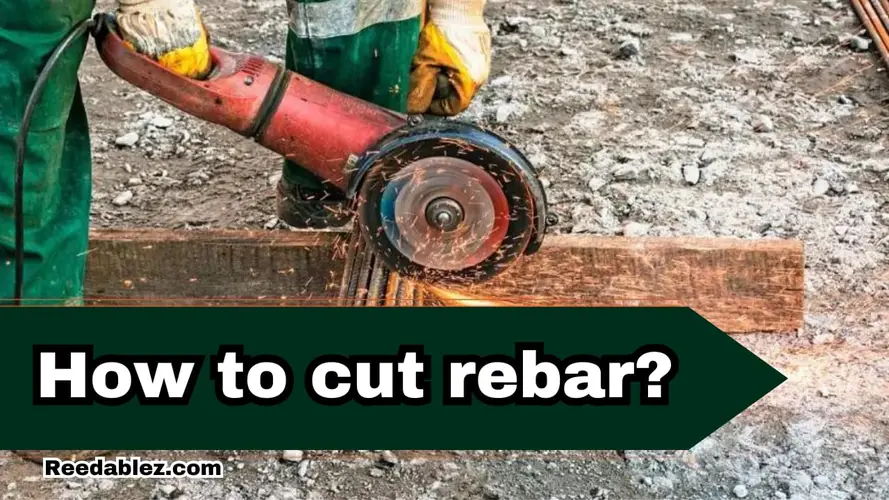How to control GPU fan speed?
April 14, 2018

Rebar, short for reinforcing bar, is a fundamental element in construction, providing strength and durability to concrete structures. Knowing how to cut and work with rebar is essential for construction professionals and DIY enthusiasts.
To cut rebar efficiently, use a quality rebar cutter, ensuring it's securely in place. Measure and mark the cutting points accurately. Employ a steady hand and make clean, controlled cuts. An angle grinder with an abrasive disc can be effective for thicker rebar or larger projects, providing versatility and speed.
In this comprehensive guide, we'll explore various methods, tools, and techniques for cutting rebar, focusing on fiberglass rebar. Additionally, we'll delve into bending fiberglass rebar, compare it with traditional steel rebar, and explore manual and tool-assisted cutting methods, including bolt cutters and angle grinders.
Understanding the varieties of rebar is essential for choosing the right type based on construction requirements.
Also known as black rebar, mild steel is the most common and economical choice. It is versatile, easily weldable, and suitable for various construction applications. However, its susceptibility to corrosion makes it less ideal for projects in corrosive environments.
To combat corrosion, epoxy-coated rebar is covered with a protective layer, acting as a barrier against environmental elements. This variety is commonly used in projects where corrosion resistance is crucial, such as marine structures or those exposed to de-icing salts.
Galvanized rebar is coated with a layer of zinc to enhance corrosion resistance. This type is suitable for projects in corrosive environments, providing durability and longevity. However, it must be noted that galvanized rebar may not be ideal for concrete with a high alkaline content.
Stainless steel rebar offers superior corrosion resistance and is ideal for projects requiring high durability and longevity. While more expensive than other types, its ability to withstand harsh environmental conditions makes it a preferred choice for bridges, highways, and coastal structures.
Complying with European standards, this rebar variety is designated with symbols like "B500A" or "B500B," indicating its tensile strength. European rebar is widely used in construction projects following European guidelines and specifications.
Factors such as the project's environment, structural requirements, and budget considerations are pivotal in selecting the appropriate rebar variety. Consulting with structural engineers and adhering to local building codes ensures correct rebar application, contributing to structural integrity and longevity of concrete constructions.
Working with rebar demands precision and adherence to safety standards to ensure the structural integrity of concrete constructions. Here are essential measures to follow when working with rebar:
Prioritize Safety by providing workers with the necessary PPE, including gloves, safety glasses, and hard hats. This safeguards against potential injuries during cutting, bending, and installation processes.
Organize rebar in a dedicated storage area, sorted by size and type. This minimizes confusion, reduces errors, and ensures easy access during installation. Proper storage also prevents damage to the rebar, maintaining its structural integrity.
Thoroughly review construction plans and specifications to accurately measure and mark rebar for cutting and placement. Precision in measurement is crucial for a successful and durable concrete structure.
Regularly inspect and test the quality of rebar materials to ensure they meet industry standards and project specifications. Quality assurance checks prevent issues during and after construction.
Utilize appropriate tools and techniques for cutting and bending rebar. Portable rebar cutters and turning jigs enhance efficiency and precision. Consider pre-cutting and turning rebar off-site for time-saving on-site installation.
Implement strict safety protocols to prevent accidents during rebar work. This includes proper training for cutting and bending tools, securing rebar during installation, and managing dust and debris.
Collaborate with other construction trades to ensure seamless integration of rebar with other structural elements. Effective communication between businesses prevents conflicts and contributes to a smoother construction process.
Develop efficient installation techniques, such as using tie-wire twisters to secure intersections quickly. Consider utilizing mechanical splices for joining rebar instead of time-consuming manual tying methods.
Provide ongoing training to construction teams on the latest rebar installation techniques, safety measures, and industry advancements. Well-trained teams are more efficient and produce higher-quality work.
Ensure compliance with local building codes and regulations. Adhering to these standards guarantees that the rebar work meets safety requirements and contributes to the overall stability of the concrete structure.
By incorporating these essential measures, construction professionals can optimize efficiency, maintain safety standards, and contribute to the successful completion of concrete construction projects.

In-depth exploration of various types of rebar cutters, from manual to electric and hydraulic options, discussing the pros and cons of each.
A step-by-step guide on using an angle grinder with an abrasive disc for cutting rebar. Emphasis on safety measures and best practices.
Techniques and considerations for cutting rebar with bolt cutters, a versatile and portable tool suitable for smaller projects.
Manual methods for cutting rebar by hand are ideal for situations where power tools are inaccessible.
Cutting and bending fiberglass rebar is a crucial aspect of construction projects where the benefits of fiberglass, such as corrosion resistance and high strength-to-weight ratio, are desired. Despite its durability, fiberglass rebar requires specific techniques for cutting and bending to ensure optimal performance in reinforced concrete structures.
When cutting fiberglass rebar, Safety is paramount. Use tools such as a circular saw with a diamond blade or a reciprocating saw. Additionally, wear appropriate personal protective equipment, including safety glasses and a dust mask.
Before cutting, accurately measure and mark the desired length of the fiberglass rebar using a measuring tape and a marker. Precision in measurement is critical to ensure a proper fit within the concrete structure.
Secure the fiberglass rebar in place using clamps or a sturdy worktable. This prevents movement during the cutting process, enhancing Safety and accuracy.
When using a circular saw, please set it to a low speed to prevent excessive heat generation. Apply steady, even pressure while cutting to avoid splintering or fraying of the fiberglass. For a reciprocating saw, use a fine-tooth blade for clean cuts.
Fiberglass produces fine particles when cut. Employ dust extraction systems or work in well-ventilated areas to minimize inhalation risks. A vacuum system or dust collection bag on the saw can also help manage debris. It would help to read How to Get Free Gems in Cooking Fever.
Fiberglass rebar can be bent using heat. Heat the specific section of the rebar using a propane torch or a heat gun. Once heated, the fiberglass becomes more pliable, allowing for bending without compromising its structural integrity.
Construct a bending jig to achieve precise bends. A bending jig ensures uniformity and consistency in the bending process. Secure the rebar within the jig and slowly bend it to the desired angle.
After bending, allow the fiberglass rebar to cool and regain its rigidity. This cooling period is crucial for the rebar to maintain its shape and strength.
By following these cutting and bending techniques, construction professionals can harness the advantages of fiberglass rebar, ensuring it integrates seamlessly into reinforced concrete structures while maintaining its structural integrity.
Efficient rebar work is crucial in construction, ensuring structural integrity and precision in the placement of reinforcing elements. Whether you're a seasoned professional or a DIY enthusiast, incorporating tips and tricks can significantly enhance your rebar cutting and working experience. Let's delve into critical strategies for efficient rebar work:
Before cutting or bending rebar, meticulous planning and accurate measurements are essential. Mark the points where cuts or bends are required. This minimizes errors and ensures that each piece fits seamlessly into the construction project.
The quality of your tools directly influences the efficiency of your rebar work. Invest in high-quality rebar cutters, benders, and other necessary tools. Quality tools not only enhance precision but also contribute to the longevity of your equipment.
For projects with repetitive rebar requirements, consider using prefabricated rebar elements. Prefabrication can save time and labor, as these elements come pre-cut and sometimes pre-bent to specific project requirements.
When using cutting tools like rebar cutters or angle grinders, adopt efficient cutting techniques. Ensure the device is held securely, and make clean, controlled cuts. Explore power tools with higher cutting capacities for large-scale projects to expedite the process.
Bundle cutting can be time-saving if your project involves numerous rebar pieces of the same length. Secure several rebar pieces together and cut them simultaneously to achieve uniform heights quickly.
When bending or shaping rebar, create supportive frameworks or templates. These frameworks guide the rebar into the desired shape, ensuring consistency across multiple pieces. This is particularly useful for projects with repetitive bending requirements.
Jigs are valuable tools for achieving precise bends and angles. Create jigs for joint bends needed in your project. This not only streamlines the bending process but also enhances the accuracy of the final product.
Invest in multi-functional tools that can perform various tasks. For example, some rebar cutters also include bending capabilities, eliminating the need for separate tools and saving time and resources.
Plan your cuts strategically to minimize material waste. By optimizing the use of rebar lengths and planning for any offcuts to be repurposed, you can reduce costs and contribute to a more sustainable construction process.
A well-organized workspace significantly improves efficiency. Keep your tools, rebar pieces, and safety equipment orderly. This saves time by reducing the search for tools and enhances overall project efficiency.
Embrace technological advancements in rebar cutting and bending. For example, CNC (Computer Numerical Control) machines provide automated precision and efficiency, especially in large-scale projects.
Efficiency should never compromise Safety. Always wear the necessary safety gear, including gloves, safety glasses, and hearing protection. Ensure your work area is well-lit and well-ventilated, and follow safety guidelines for each tool.
Regularly maintain and inspect your tools. Dull blades or worn-out parts can hinder efficiency and compromise the quality of your work. Keep tools in optimal condition to ensure smooth operation.
If you encounter challenges or uncertainties, seek advice from experienced professionals. Attend workshops or training sessions to enhance your skills and stay updated on the latest techniques and tools in rebar work.
Efficient rebar work combines skill, precision, and the right tools. By implementing these tips and tricks, you can streamline your rebar cutting and bending processes, contributing to the success and efficiency of your construction projects.
Becoming proficient in cutting and working with rebar is essential for anyone involved in construction projects. Whether dealing with traditional steel or the innovative fiberglass alternative, understanding the tools, techniques, and safety measures ensures a successful and secure construction experience. This guide equips you with the knowledge to master the art of working with rebar, contributing to the strength and longevity of your concrete structures.
Use a circular or reciprocating saw with a diamond blade. Secure the rebar, mark the cut, and apply steady, even pressure. Employ safety gear and manage fiberglass dust.
Heat a specific section with a propane torch or heat gun, then bend using a jig for precision. Allow cooling for structural integrity.
Fiberglass rebar offers corrosion resistance, is lighter, and doesn't conduct electricity. Steel is heavier but may be preferred for specific applications based on cost and tensile strength requirements.
Mark the cut, use a hacksaw, align the blade, and make steady, even strokes. Wear gloves and safety glasses for protection.
Secure the rebar, align the bolt cutter jaws with the mark, and make the cut using the cutter's leverage. Bolt cutters are efficient for smaller-diameter rebar.
Secure the rebar, mark the cut, wear safety gear, and use an angle grinder with a cutoff wheel. Apply steady pressure and follow the marked line for a clean cut.
Comments
Write a comment